Information/Write-up
Johnny Cowell (1926–2018)
Trumpeter, Composer, Arranger, Canadian Musical Icon
Johnny Cowell was one of Canada’s most distinguished musical figures—a virtuoso trumpeter, prolific composer, and beloved orchestral member whose career spanned over seven decades and bridged the worlds of classical, pop, and symphonic music.
Born in the southwestern Ontario town of Tillsonburg, Cowell showed early musical promise, performing his first solo at age six on a dented, hand-me-down trumpet. By age eight, he was a featured soloist with the town band, his arrangements written by his mother. Self-taught in his early years, Cowell’s musical instinct and ear for melody would become lifelong hallmarks. At fifteen, he was accepted into the Toronto Symphony Band under conductor “Puff” Addison, becoming its youngest member and regular soloist on CBC Radio broadcasts. A year later, he played his first engagement with the Toronto Symphony Orchestra (TSO), and by sixteen was performing professionally alongside Canada’s top classical musicians.
During World War II, Cowell joined the Royal Canadian Navy and served as cornet soloist with the HMCS Naden Band in Esquimalt, British Columbia. He also held the first trumpet chair with the Victoria Symphony and performed dance band gigs, Dixieland shows, and parades. On VJ Day in 1945, following an exhausting marathon of concerts and parades, he severely damaged his embouchure—doctors told him he would never play again.
Temporarily silenced, Cowell turned to composition. He taught himself orchestration by studying Beethoven scores and submitted a full symphonic suite to the Royal Conservatory of Music, which awarded him a scholarship. He studied under John Weinzweig and Oskar Morawetz, but never gave up on trumpet entirely. After years of slow rehabilitation, he gradually regained his embouchure and returned to performance. In 1952, Cowell rejoined the TSO after a rigorous audition process, beginning a tenure that would last nearly 40 years.
As a trumpet soloist, Cowell became one of Canada’s most respected performers, lauded for his golden tone, clarity, and expressiveness. He performed with major orchestras across North America and drew glowing praise from Erich Kunzel, who called him “a rare combination of Wynton Marsalis, Maurice André, and Gerard Schwarz—with a bit of Harry James thrown in.”
Parallel to his classical work, Cowell became one of Canada’s most successful pop composers. He wrote over 200 songs, with at least 150 recorded commercially. His 1956 ballad “Walk Hand in Hand”, first recorded by Tony Martin, became an international chart-topper and was later covered by Andy Williams, Gerry & The Pacemakers, and numerous others. In 1963, pianist Bill Pursell’s version of Cowell’s “Our Winter Love” reached No. 9 on the Billboard Hot 100, becoming a seasonal radio favorite across North America and the UK.
His compositions were performed by a diverse list of artists: Chet Atkins, Al Hirt (who recorded his “Strawberry Jam”), The Guess Who (“His Girl”), Moe Koffman, Anita Bryant, The Lettermen, and Dame Vera Lynn, among many others. His songwriting success led to contracts with BMI and publishers in New York, cementing his place as a dual force in both classical and commercial music.
As tastes shifted in the late 1960s, Cowell turned toward symphonic pops. Encouraged by conductors like Seiji Ozawa and Erich Kunzel, he composed dazzling works for orchestra such as “Girl on a Roller-Coaster”, “Canadian Odyssey”, and “Famous Trumpeters”, a 40-minute tribute to brass legends like Louis Armstrong and Harry James. His encore composition “A Farewell Tribute to the Grand Old Lady of Shuter Street” celebrated Massey Hall before the TSO’s move to Roy Thomson Hall.
In 1991, the Toronto Symphony held a historic tribute concert in Cowell’s honour—marking his retirement with a sold-out evening at Roy Thomson Hall that celebrated his dual talents as a performer and composer. It was the first time in the TSO’s history that a single member had been recognized with such a concert.
Even after retirement, Cowell continued to perform and compose. He became principal trumpet with the Toronto Philharmonia for a decade and was a featured soloist with the Hannaford Street Silver Band for eight years. He also played with the Pro Arte Orchestra of Canada for sixteen seasons. In 1984, he was commissioned to write fanfares for both Governor General Jeanne Sauvé and Her Majesty The Queen. He received the Civic Award of Merit from Scarborough in 1997, and was later inducted into the Scarborough Walk of Fame (2007) and presented with the Toronto Musicians’ Association Lifetime Achievement Award (2005).
His recordings—including The Art of Johnny Cowell and Carnival of Venice: Great Showpieces for Trumpet and Orchestra—received international acclaim, and even caught the attention of trumpet great Doc Severinsen, who personally phoned Cowell to express admiration for his artistry.
Cowell was married for over 60 years to vocalist Joan Mitchell, whom he met while performing with Stanley St. John’s orchestra. Their musical and personal partnership remained strong throughout his life.
Johnny Cowell passed away in 2018 at the age of 92, leaving behind a catalogue of enduring music that continues to inspire musicians and audiences alike. From his humble beginnings in Tillsonburg to the concert halls of the world, Cowell’s life was a triumph of talent, tenacity, and love for the art of sound.
-Robert Williston
Calling Johnny Cowell a virtuoso trumpeter is fair comment, but it touches only a few bases in the career of this extraordinary musician. The whole truth, I guess, would have made for a very cumbersome album title. Johnny is certainly a great trumpet player, but he’s also a composer, an arranger, a symphony musician, and a recording artist. He’s written music for every conceivable music ensemble—from small groups to full symphony orchestras.
Johnny Cowell was born in a small town near London, Ontario, and made his debut as a trumpet soloist at the age of six. Since then he’s been involved in every aspect of the music scene, and hundreds of his songs have been recorded by artists like Tony Martin, Andy Williams, Andre Kostelanetz, Lawrence Welk, Al Hirt, Floyd Cramer and Hugo Winterhalter, and, as well, have appeared on the many albums that Johnny has released himself.
In some ways, The Virtuoso Trumpet of Johnny Cowell is a “cross-over” album, one of those curiously defined records that literally cross the boundaries between pop and classical music. Johnny Cowell was one of the first in the current generation of musicians to meet composers like Bach, Handel, Beethoven, and Satie head on, and to bring his own musical sensibilities and style to their work. Side Two of this album demonstrates how successfully a bridge can be built between the 18th and 19th centuries and the 20th century.
Side One lets us in on the original work of Johnny Cowell. Actually, the first piece, “Napoli,” is an arrangement of a Neapolitan song that’s been a favorite of operatic tenors for many years. But in Johnny’s arrangement it becomes a brand new song—in a virtuoso display of trumpet playing that should make any tenor stop singing and just listen!
The lovely, very fresh sounding standard “Stardust” is followed by a piece from Johnny's ‘Spanish period’: “Sangre de Toro Bravo,” which captures the heat and light of Spain, and the excitement and romance of the bullring.
“Butterscotch” has that rich, creamy sound the title would suggest, poured over one of Johnny’s great melodies. And if you want an example of Johnny’s skills as an arranger and some terrific ensemble playing, just wait for “Lonely Trumpet,” with some superb horn playing blending with the other musicians.
The last cut on the side, “Roller Coaster,” has been a hit with orchestras and audiences ever since it was commissioned by conductor Seiji Ozawa as an encore piece for the Toronto Symphony’s tour of Japan in 1969. “Roller Coaster” has logged a lot of miles since then—Ozawa programmed it again for the New York Philharmonic’s tour of Europe, and the Prince of Pops, Erich Kunzel, has featured it with almost every major symphony orchestra in North America. It’s odd that this is its debut on record. A long overdue debut it is. This recording features three great solo trumpeters: Johnny Cowell, Larry Weeks, and Bart Woomert. “Roller Coaster” is a dazzler indeed!
Handel and Bach arrived at their 300th birthdays in 1985, and Johnny Cowell was more than ready for the celebrations. Over the years, he’s been drawn to the major composers in the classical field, and has made contemporary arrangements of some of the best-known and best-loved works in that repertoire.
From the uplifting “Rejoice” by Handel, through the famous “Air on a G String” from J. S. Bach’s Orchestral Suite No. 3, to the contemplative “Arioso,” again by Bach, Johnny Cowell blends his skill as a performer and arranger with the dignity and musicality of the baroque period.
There are two bonuses as well. Johnny has arranged music from the last movement of Beethoven’s great Symphony No. 9, which was originally scored for soloists, choir, and orchestra. This instrumental version weaves through the “Song of Joy,” and it comes with a guarantee that the tune will stay in your head for the rest of the day!
The side ends with a thoughtful and soothing arrangement of the “Gymnopedie No. 3” by the French composer Erik Satie. This eccentric musician wrote a number of ‘little’ pieces, and this Gymnopedie has one of the most captivating melody lines of any work written in the 20th century.
The art of Johnny Cowell: player, composer, arranger. It’s all here on The Virtuoso Trumpet of Johnny Cowell.
-Terry Campbell
Host, Stereo Morning
Canadian Broadcasting Corporation
Produced by Johnny Cowell and Bill Kearns
Recorded at Manta Sound, Toronto, Ontario
Compilation Editor: Mary Secord
Album Design by Mark Cooper/Amazing Graphics
Artist Photo by Paul Hoeffler
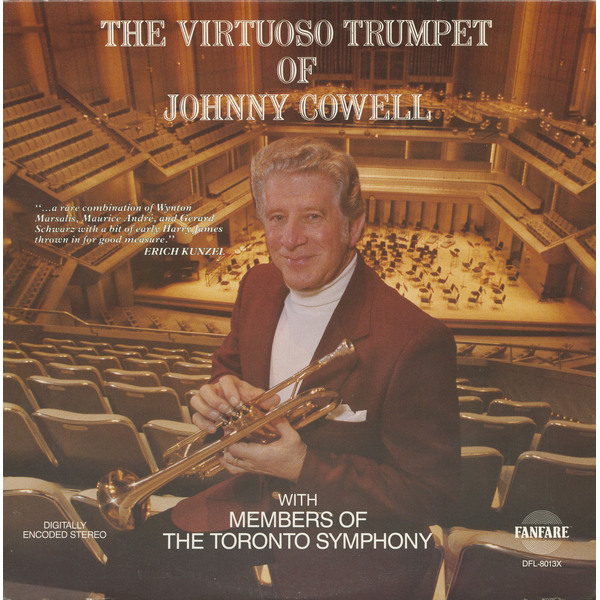
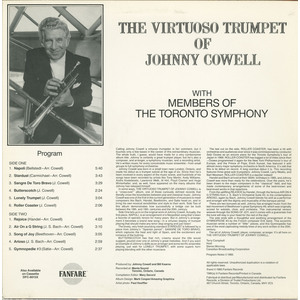
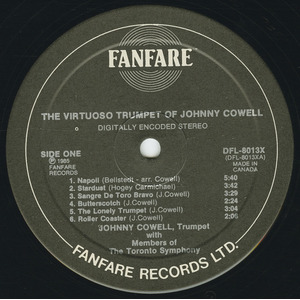
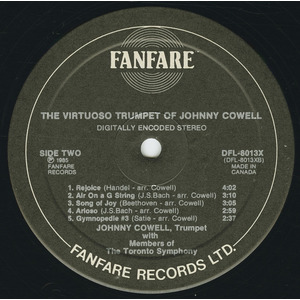
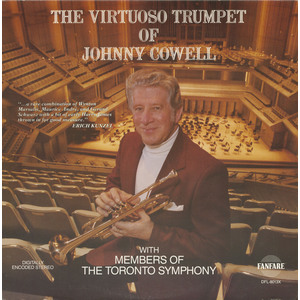
No Comments